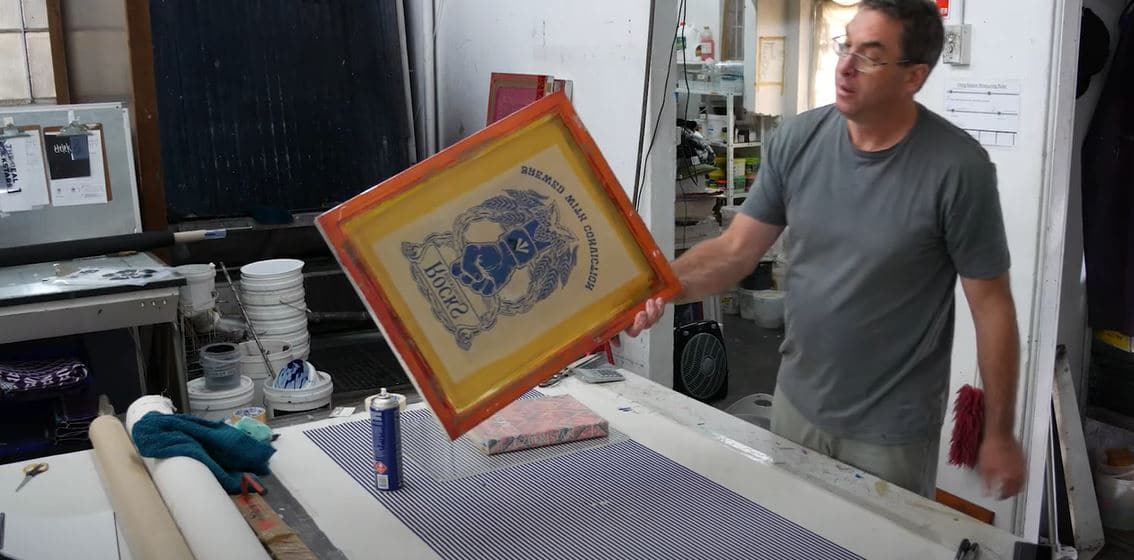The Vital Guide to Comprehending Screen Printing and Its Versatile Makes use of
Screen printing has a rich background that goes back to ancient times, advancing right into an advanced strategy used throughout numerous industries today. This overview explores the complexities of the screen printing procedure, outlining its applications in advertising and marketing, style, and home decoration - 10:9 Design Screen Printing. Recognizing these principles can open up creative potential for both imaginative and commercial jobs. The following areas will reveal vital pointers and strategies to improve one's screen printing endeavors
The Background of Screen Printing
Although screen printing has roots that map back centuries, its development reflects the artistic and technical innovations of various societies. Originating in ancient China, the technique was at first utilized for embellishing textiles and later spread to Japan, where it became indispensable to Ukiyo-e woodblock printing. The method shifted to Europe in the 18th century, where it acquired appeal among craftsmens and business printers. The invention of image solution in the 20th century revolutionized screen printing, permitting even more detailed styles and greater effectiveness. Musicians like Andy Warhol additionally pushed its popularity, making use of the tool to produce legendary jobs that blended commercialism and art. By the late 20th century, screen printing had actually established itself as a functional method, used in vogue, advertising and marketing, and art. Today, it proceeds to advance, integrating digital technology and increasing its applications throughout various industries.
The Screen Printing Refine Explained
Screen printing changes imaginative visions right into concrete layouts with a collection of accurate steps. Initially, an image is produced and after that transferred onto a screen, typically constructed from fine mesh material extended over a frame. A light-sensitive emulsion is related to the screen, which is exposed to light, hardening in locations not covered by the image. After rinsing the unhardened emulsion, a stencil is developed.
Next off, the screen is placed over the substrate, whether it be fabric, paper, or an additional material. Ink is after that pushed via the open locations of the pattern using a squeegee, depositing the design onto the substrate listed below. This process can be duplicated for multiple colors, requiring different screens for every tone. The published product is healed using warmth to ensure the ink sticks effectively, resulting in a resilient, vibrant style ready for use.
Kinds Of Screen Printing Techniques

In addition, specialty techniques, such as discharge screen printing, remove color from the material to produce softer prints, while aluminum foil screen printing applies metallic aluminum foil to achieve a glossy finish (10:9 Design reviews). Each technique provides distinct characteristics, satisfying various creative needs and manufacturing scales, inevitably increasing the possibilities within the screen printing domain name
Applications of Screen Printing in Numerous Industries

In addition, the signs and advertising and marketing markets use screen printing for producing captivating screens and banners. This approach permits for vibrant colors and complex styles that capture focus. In electronics, screen printing is employed for applying conductive inks to motherboard, important for component links. In addition, the home décor market embraces screen printing to create distinctive layouts on fabrics and wall surface art. Generally, screen printing offers as a vital tool across diverse fields, enhancing items with individualized and aesthetically appealing graphics.
Tips for Effective Screen Printing Projects
While carrying out a screen printing project, cautious focus to detail can substantially boost the final result. Initially, selecting top quality materials is crucial; this includes the screen, inks, and substratums. Using appropriate mesh matters can impact ink deposition and information resolution. Preparation is equally essential; complete cleansing of displays and correct exposure times assure crisp prints.
Next off, precise enrollment is critical for multi-color prints. Making use of positioning tools can assist achieve specific layering. Additionally, testing prints on scrap materials prior to manufacturing helps identify possible issues without losing sources.

Often Asked Questions
What Materials Are Finest for Screen Printing on Material?
Cotton and polyester blends are perfect for screen printing on textile as a result of their longevity and ink absorption. Furthermore, specialized fabrics like silk or canvas can produce special appearances and coatings, improving the total style high quality.
Just how Do I Tidy and Maintain Screen Printing Devices?
To clean up and preserve screen printing tools, here one should on a regular basis wash screens with ideal solvents, evaluate mops for wear, lube moving components, and store all products in a completely dry, dust-free setting to prolong their life-span.
What Are the Environmental Effects of Screen Printing?
Screen printing can have substantial environmental impacts, consisting of chemical waste from inks and solvents, water use throughout cleansing procedures, and energy consumption. Lasting methods and green materials are vital for lessening these negative impacts.
Can Screen Printing Be Done in your home Effectively?
Screen printing can be properly done at home with the best products and strategies. Hobbyists can create top quality prints, though success relies on their ability degree, devices, and understanding of the process entailed.
What Are the Prices Related To Beginning a Screen Printing Service?

Beginning a screen printing business includes prices for devices, products, and workspace. First costs usually vary from a few hundred to a number of thousand dollars, relying on the range, high quality of machinery, and desired manufacturing ability.
Screen printing has an abundant background that dates back to ancient times, developing right into a sophisticated strategy used across different sectors today. An additional technique, rotating screen printing, uses cylindrical displays, helping with constant printing on fabric rolls, thus enhancing efficiency for large manufacturings. In addition, specialty strategies, such as discharge screen printing, get rid of color from the fabric to develop softer prints, while aluminum foil screen printing uses metal aluminum foil to accomplish a glossy surface. In the fashion industry, screen printing is extensively utilized to create dynamic designs on garments, allowing brands to showcase their distinct styles. Cotton and polyester blends are optimal for screen printing on fabric due to their sturdiness and ink absorption.